Jazz Nights (14)
The Kimbrough-Locke duo is the first part of our 2006 Vibraphone
Festival in which we present two of today's best vibraphonists. Part two
will be next May, when Steve Nelson plays with Kirk Lightsey and Ray Drummond.
In part three, to take place June 25th 2006, Joe Locke returns in a very
different setting in a collaboration between JazzNights and the Princeton
Festival.
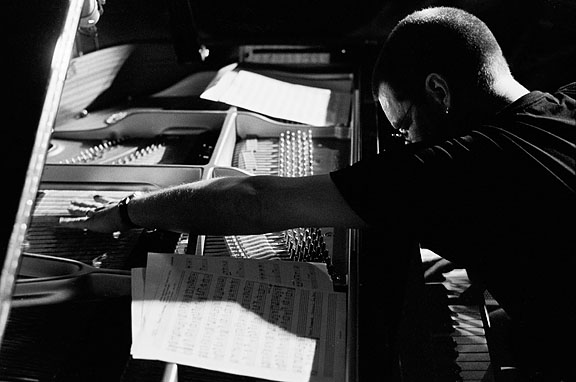 JazzNights began with duos,
thereby providing a chance for the audience to hear musicians thinking together
in a most intimate setting. Although we definitely want to give you the
opportunity to hear many different kinds of groups, we have become convinced
that we should never abandon our duos - there is nowhere else we know that
regularly presents that kind of music in such a setting. Although we are
returning to our roots in February, we are also presenting a new instrument
for us, our first - but not last! - vibraphone. Why the vibraphone? First
of all, it is a fascinating instrument with a long tradition in jazz, one
that combines percussion with multi-mallet chordal possibilities and horn-like
two-mallet playing. Most jazz fans are familiar with the vibraphone through
Lionel Hampton, but the first rate music really began with Red Norvo. Listen
to his unamplified xylophone (Dance of the Octopus with Benny Goodman),
or the great trio with Mingus and Tal Farlow, or, best of all, his work
with singer Mildred Bailey. The xylophone hasn't come back, but it's big
brother, the wonderfully woody marimba has, and many of today's young vibraphonists
play it.
JazzNights began with duos,
thereby providing a chance for the audience to hear musicians thinking together
in a most intimate setting. Although we definitely want to give you the
opportunity to hear many different kinds of groups, we have become convinced
that we should never abandon our duos - there is nowhere else we know that
regularly presents that kind of music in such a setting. Although we are
returning to our roots in February, we are also presenting a new instrument
for us, our first - but not last! - vibraphone. Why the vibraphone? First
of all, it is a fascinating instrument with a long tradition in jazz, one
that combines percussion with multi-mallet chordal possibilities and horn-like
two-mallet playing. Most jazz fans are familiar with the vibraphone through
Lionel Hampton, but the first rate music really began with Red Norvo. Listen
to his unamplified xylophone (Dance of the Octopus with Benny Goodman),
or the great trio with Mingus and Tal Farlow, or, best of all, his work
with singer Mildred Bailey. The xylophone hasn't come back, but it's big
brother, the wonderfully woody marimba has, and many of today's young vibraphonists
play it.
Lionel Hampton was a ham-fisted drummer, but a marvelously
inventive, subtle, and swinging vibraphonist. His work with the Benny Goodman
Quartet is still fresh and exciting - and easily available. Check out as
well his other small group work with quintets and sextets drawn from the
big bands of the time - The best vinyl collection I know is called "Hot
Mallets" and it is available on CD as well: Bluebird (6458-2-RB). The
Goodman quartet - and Goodman - deserve much more credit than they get both
musically and socially. Not only was the music great, but the Goodman quartet
was seriously integrated at a time when blacks and whiles almost never played
together in public (after hours gigs were another matter). And the Goodman
quartet was truly mixed - both Teddy Wilson and Hampton were black. Representative
discs of all these artists appear fairly often in the $4-5 bins at the Princeton
Record Exchange.
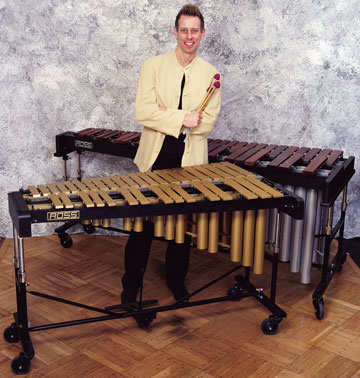
Milt Jackson was to the vibraphone what Charlie Parker
and Bud Powell were to the saxophone and the piano. Toward the middle of
the last century an almost miraculous change came over jazz. Suddenly, the
harmonic and rhythmic complexity of the music dramatically increased, recapitulating
some of the changes in classical music in the 20th century. These artists
and a few others, Jackson among them, created the form called bop, the modern
idiom of jazz, and one that still is influential today. Out of that modern
tradition come today's group of excellent vibraphonists - Locke, Steve Nelson,
and Stefon Harris for example. You'll get to hear two of them in 2006.
The duo we begin with is just remarkable. Mr. Kimbrough
is one of the most versatile and brilliant of today's pianists and Mr. Locke
is a worthy inheritor of the tradition of Milt Jackson. The two work together
often and have a pair of excellent CDs, "Saturn's Child," a strictly
duo recording, and the expanded "The Willow," which adds Tim Ries
on woodwinds and drummer Jeff Ballard, who plays hand percussion on this
CD. The week after JN14, Kimbrough and Locke will record a live duo CD.
JazzNights 14 will be an excellent example of what might be called
chamber jazz, but don't be fooled - it is likely to be quiet, but it won't
be dull. These two musicians produce beautiful music with no loss of intensity
or passion. Here's what Downbeat's Jon Andrews said about "Saturn's
Child" in his review:
"These luminous duets offer plenty of substance and
creativity....mellow but interesting, complex but not cluttered, and frequently
lovely. Saturn's Child may inspire new appreciation for the importance of
balance and touch."
In a musical world all too often fragmented, in which groups
rapidly come and go and infrequently remain together long enough for real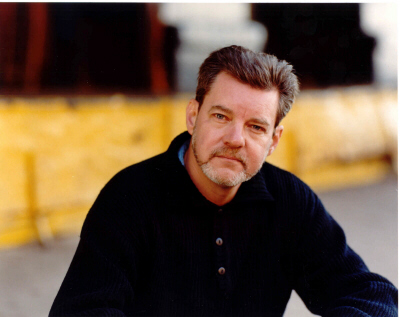 empathy to develop, Frank
Kimbrough is interested in long-term projects. In 1992, for example,
he joined the Jazz Composers Collective, an organization that has prospered
over the years, and not only produced a series of remarkable CDs and concerts
of new music, but spun off the marvelous Herbie Nichols Project , which
Mr. Kimbrough co-leads with bassist Ben Allison. The Nichols Project has
kept alive the work of Nichols, a much-neglected pianist and composer who
many compare to Monk in creative impact. Mr. Kimbrough also has a long association
with the Maria Schneider Orchestra. In fact, he will be on a short break
from touring with them when he plays with us this February. It may seem
odd, but the huge Maria Schneider Orchestra and the tiny Kimbrough-Locke
duo are musically rather similar. Both are alert to the importance of nuance
and color, for example, and both take jazz to new places, or at least to
places infrequently seen. Of course, he is also alive in the more traditional
world of small groups. We'll note some CDs below, but don't miss Lullabluebye,
a trio CD with Ben Allison and drummer Matt Wilson devoted to Kimbrough
compositions.
empathy to develop, Frank
Kimbrough is interested in long-term projects. In 1992, for example,
he joined the Jazz Composers Collective, an organization that has prospered
over the years, and not only produced a series of remarkable CDs and concerts
of new music, but spun off the marvelous Herbie Nichols Project , which
Mr. Kimbrough co-leads with bassist Ben Allison. The Nichols Project has
kept alive the work of Nichols, a much-neglected pianist and composer who
many compare to Monk in creative impact. Mr. Kimbrough also has a long association
with the Maria Schneider Orchestra. In fact, he will be on a short break
from touring with them when he plays with us this February. It may seem
odd, but the huge Maria Schneider Orchestra and the tiny Kimbrough-Locke
duo are musically rather similar. Both are alert to the importance of nuance
and color, for example, and both take jazz to new places, or at least to
places infrequently seen. Of course, he is also alive in the more traditional
world of small groups. We'll note some CDs below, but don't miss Lullabluebye,
a trio CD with Ben Allison and drummer Matt Wilson devoted to Kimbrough
compositions.
Joe Locke is regarded by many as the premier vibraphonist of our day. He
can play chamber duets, such as those you will hear in 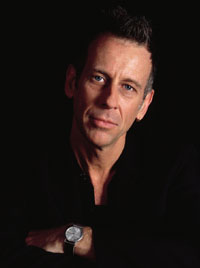 February, that are complex but soft and exceptionally lyrical.
But he has also played renowned duets with pianist Cecil Taylor, an icon
of "outside" jazz playing. Their three-day series of duets has
been described as "volcanic," and I can well believe it. Like
Milt Jackson in his Modern Jazz Quartet role, Mr. Locke can often be soft
- play pretty - without losing his musical inventiveness or becoming the
least bit saccharine or uninteresting. Or, like Jackson in his bop-innovator
role, he can swing like mad, which is what this duo will do a lot.
February, that are complex but soft and exceptionally lyrical.
But he has also played renowned duets with pianist Cecil Taylor, an icon
of "outside" jazz playing. Their three-day series of duets has
been described as "volcanic," and I can well believe it. Like
Milt Jackson in his Modern Jazz Quartet role, Mr. Locke can often be soft
- play pretty - without losing his musical inventiveness or becoming the
least bit saccharine or uninteresting. Or, like Jackson in his bop-innovator
role, he can swing like mad, which is what this duo will do a lot.
Joe Locke also plays in a variety of important groups,
some rather experimental, such as his 4 Walls of Freedom quartet (Locke,
Gary Novak on drums, Ed Howard on bass, and Tommy Smith on tenor), or more
traditional such as the Milt Jackson Tribute Band (Locke, Mike LeDonne on
piano, Bob Cranshaw on bass, and Mickey Roker on drums) the very different
group that JazzNights will bring to the Princeton Festival next June
25th - stay tuned for an announcement of this Part Three of the 2006 Vibes
Festival.
"Something about the vibes, perhaps the unique combination
of percussion and melody, seems to attract the best and most versatile
musicians."
Jonny King, "An Insiders's Guide to Understanding
and Listening to Jazz"
You can hear Joe Locke in NYC:
February 3,4 at The Kitano with the Ben Wolfe quartet:
Wolfe, Locke, Renee Rosnes (JN8), and Carl Allen - highly recommended!
You can hear Frank Kimbrough in NYC:
January 11 with the Maria Schneider Orchestra at the IAJE
convention
January 12 at the 55 Bar with vocalist Kendra Shank.
February 10, at the Jolly Hotel Madison Towers with Kendra
Shank.
Historical Xylophonic /Vibraphonic CDs:
Norvo:
Red Norvo Featuring Mildred Bailey, Portrait Masters, RK
44118
The Norvo-Mingus-Farlow Trio, Vintage Jazz Classics, VJC
1008-1, 1008-2
Hampton:
Hot Mallets, Bluebird 6458-2-RB
Kimbrough and Locke CDs:
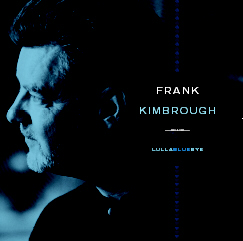
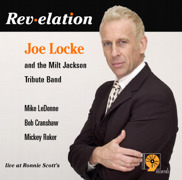
Frank Kimbrough:
Chant (Kimbrough, Allison, Ballard, IGM 49807-2
Lullabluebye (Kimbrough, Allison, Wilson), Palmetto, PM
2100
Joe Locke:
But Beautiful (Locke, Kenny Barron) Steeplechase SCCD 31295
Dear Life 4 Walls of Freedom, (Locke, Novak, Howard, Smith)
Sirocco SJL1025
Rev-elation (Locke, Mike LeDonne, Bob Cranshaw, Mickey Roker), Sharp Nine 1033
Frank Kimbrough-Joe Locke
Beauty Burning (with Ray Drummond [JN8], Jeff Watts, Paul
Bollenbeck) Sirocco SJL1008
Saturn's Child, OmniTone, 11901
The Willow (with Ballard, Tim Reis), OmniTone 12201
 JazzNights began with duos,
thereby providing a chance for the audience to hear musicians thinking together
in a most intimate setting. Although we definitely want to give you the
opportunity to hear many different kinds of groups, we have become convinced
that we should never abandon our duos - there is nowhere else we know that
regularly presents that kind of music in such a setting. Although we are
returning to our roots in February, we are also presenting a new instrument
for us, our first - but not last! - vibraphone. Why the vibraphone? First
of all, it is a fascinating instrument with a long tradition in jazz, one
that combines percussion with multi-mallet chordal possibilities and horn-like
two-mallet playing. Most jazz fans are familiar with the vibraphone through
Lionel Hampton, but the first rate music really began with Red Norvo. Listen
to his unamplified xylophone (Dance of the Octopus with Benny Goodman),
or the great trio with Mingus and Tal Farlow, or, best of all, his work
with singer Mildred Bailey. The xylophone hasn't come back, but it's big
brother, the wonderfully woody marimba has, and many of today's young vibraphonists
play it.
JazzNights began with duos,
thereby providing a chance for the audience to hear musicians thinking together
in a most intimate setting. Although we definitely want to give you the
opportunity to hear many different kinds of groups, we have become convinced
that we should never abandon our duos - there is nowhere else we know that
regularly presents that kind of music in such a setting. Although we are
returning to our roots in February, we are also presenting a new instrument
for us, our first - but not last! - vibraphone. Why the vibraphone? First
of all, it is a fascinating instrument with a long tradition in jazz, one
that combines percussion with multi-mallet chordal possibilities and horn-like
two-mallet playing. Most jazz fans are familiar with the vibraphone through
Lionel Hampton, but the first rate music really began with Red Norvo. Listen
to his unamplified xylophone (Dance of the Octopus with Benny Goodman),
or the great trio with Mingus and Tal Farlow, or, best of all, his work
with singer Mildred Bailey. The xylophone hasn't come back, but it's big
brother, the wonderfully woody marimba has, and many of today's young vibraphonists
play it. 
 empathy to develop,
empathy to develop,  February, that are complex but soft and exceptionally lyrical.
But he has also played renowned duets with pianist Cecil Taylor, an icon
of "outside" jazz playing. Their three-day series of duets has
been described as "volcanic," and I can well believe it. Like
Milt Jackson in his Modern Jazz Quartet role, Mr. Locke can often be soft
- play pretty - without losing his musical inventiveness or becoming the
least bit saccharine or uninteresting. Or, like Jackson in his bop-innovator
role, he can swing like mad, which is what this duo will do a lot.
February, that are complex but soft and exceptionally lyrical.
But he has also played renowned duets with pianist Cecil Taylor, an icon
of "outside" jazz playing. Their three-day series of duets has
been described as "volcanic," and I can well believe it. Like
Milt Jackson in his Modern Jazz Quartet role, Mr. Locke can often be soft
- play pretty - without losing his musical inventiveness or becoming the
least bit saccharine or uninteresting. Or, like Jackson in his bop-innovator
role, he can swing like mad, which is what this duo will do a lot. 
